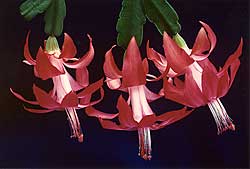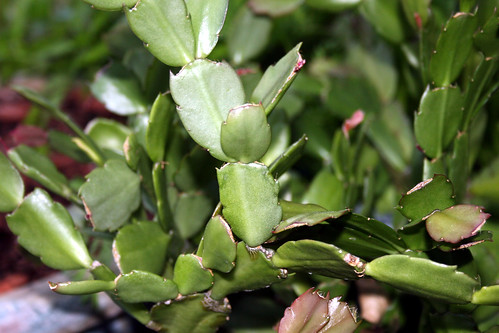I have two cactus like plants. One is a Thanksgiving Cactus and the other is of the same species, Schlumbergera, and is known as a Christmas Cactus.
General care for plants of the Schlumbergera species is to give them moderate to bright light in the Spring and Summer months. Lighting depends upon exactly which species you own.
I’ve found that these cactus can burn in direct bright sunlight so I generally put mine outside in the summer time in an area where they only get bright direct sunlight for a couple of hours. The rest of the lighting they receive is usually fairly bright but not direct.
Come mid-September this year I moved my two cactus’ to my enclosed front porch. The porch faces north so the light levels are very low from September through to April or so.
Generally, to get these plants to flower when they are supposed to flower you should put them in a cool dark place from Mid September through October and barely water them if at all during that time. At the end of October you can bring them out of the darkness and place them in a fairly bright area of your home and water them as you normally would.
Occasionally fertilizing the plants through summer and a weak dose of fertilizer shortly after you bring them out of dormancy might help them to flower as well.
I experimented a bit this year.
You see, my Thanksgiving Cactus is about 6 years old and it’s always been a fairly good flower producer. My Christmas Cactus on the other hand, which is treated almost exactly the same as the Thanksgiving Cactus, is rather stingy when it comes to flowering.
When my mother died in 2004 my sister and I each took one of the 50+ year old Christmas Cactus. We knew one flowered better than the other. Guess which one my sister got? She just has to look at it and it flowers! I’m so jealous!
This year instead of bringing the cactus’ to the cool dark basement in Mid-September I put them in the enclosed front porch as I said early. Their lighting was diminished and they got the benefit of the cool late summer nights while on the porch.
It was only two weeks ago when outside night time temperatures were starting to come close to zero or lower that I brought them inside to the dark basement.
Checking on them today in the basement I noticed that both cactus have tiny flower buds on the tips of their thick succulent leaves. It looks like my experiment might have worked!
Now I do have to confess that I made a real rookie move that I should have known not to do.
The Christmas cactus is old and as a result it’s HUGE. Like 3+ feet in diameter. How can you bring that into the living room or kitchen and place it somewhere where it won’t be disturbed and where it will bloom prettily?
I trimmed it! I really should have waited until the plant finished blooming before I trimmed off the newer growth. By trimming it before it flowered I might have destroyed it’s ability to bloom this year. Oh well … it’s not like I’m used to that Cactus blooming much anyway.
Of course I only trimmed a little bit off the edges. It’s still more than two feet in diameter. If you’d like to trim your Christmas or Thanksgiving cactus’ wait until they’ve finished blooming and then only trim a little bit of the soft newer green growth from the tips. Do not trim back to the older woody growth as that could damage the plant. Also, never trim too much off of any plant at one time as that could send it into shock.
I’ll let you know if the Christmas cactus blooms well, poorly or barely at all this year as a result of my experiment and my too early trimming!
I’ve brought both plants up and put them on tables or stands in my living room dining room and upon close inspections both have a fair number of buds. Perhaps the Christmas Cactus will bloom well, if early, this year?

